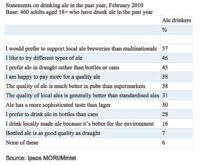 The steady decline of the ales/stout market has worsened over the past decade. In 1998, these darker beers accounted for 40% of all beer volume sales in the UK, but just ten years later this had slipped to 25%.
The steady decline of the ales/stout market has worsened over the past decade. In 1998, these darker beers accounted for 40% of all beer volume sales in the UK, but just ten years later this had slipped to 25%.
Key to the demise of ales & stouts has been the rise in popularity of lager. Younger men have been attracted to being served a cold and refreshing drink, rather than the more complex taste of ales and stouts.
One of the key problems for the sector has been the fact that brewers have failed to change a common misconception that ale is at its best when served cool rather than at room temperature.
However, this latest research shows after years of sharp decline, the ale market performed much better in 2009, slowing its rate of decline significantly and increasing its share of the overall beer market at lager’s expense.
The success of cask ale has been instrumental in slowing the decline of ale. Between 2005 and 2008, on-trade volume sales of ale fell by 23%. But in 2009 ale out-performed lager, slowing its decline to a more respectable 4.8%.
Meanwhile, stout – a category in which Guinness accounts for a 90% share – has not seen such a steep decline over the past five years, but like ale has struggled with the decline in on-trade revenue, particularly in 2008.
Both ales & stouts struggle from an over-reliance on the on-trade; a precarious predicament as drinkers increasingly migrate to the off-trade. Indeed, both the ale and stout markets have suffered from an over-reliance on pub revenues which are also experiencing decline: a record number of pubs went out of business in 2009.
In terms of numbers, ale/stout’s share of off-trade volume sales has remained largely static (29%), although they are slowly increasing their share within the multiples. The decline of canned sales is partially being offset by the increasing uptake of bottled ales and stouts.
But increased consumer expenditure in years to come, as well as a period of consolidation for pubs, should enable both ale and stout to further slow their sales decline over the next five years.
Indeed, a new generation of younger beer drinkers are starting to appreciate colder ale, which is helping propel sales of cask ale. This type of ale has more of a unique flavour than standardised brands.
Overall, ale/stout drinkers look for very different things when deciding what beer to drink, compared to lager drinkers. They are far more focused on the provenance, as well as the quality and individuality of the taste, rather than it simply being for refreshment.
Ale drinkers appreciate the very fact that unlike lager, ale is unique, quirky and non-standardised.
The success of the growing number of local microbreweries has tapped into national pride at having a locally made product with authentic British provenance, as well as appealing to the increasing desire for more boutique, rather than mass-produced products.
Younger drinkers (under-45s) are both more adventurous and arguably more discerning in their attitudes towards ale compared to older drinkers.




Comments are closed.